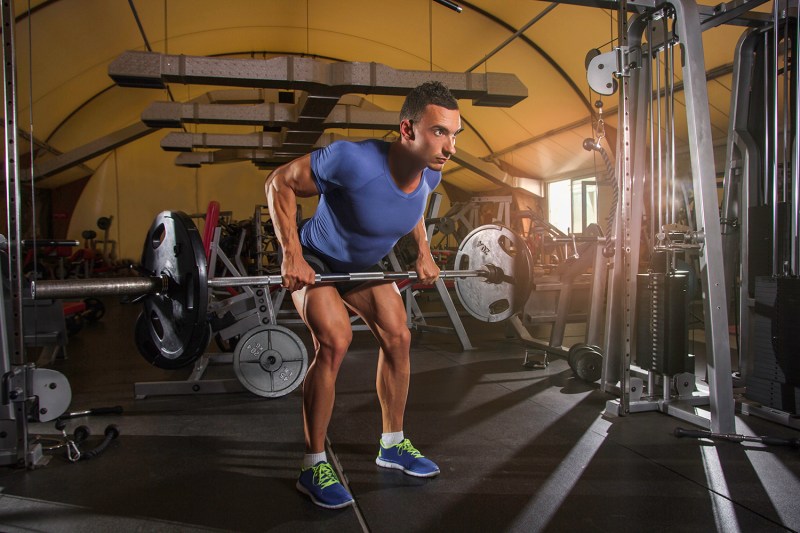When you want to bulk up your back muscles, the one exercise that needs to be on your list is the bent-over barbell row. This exercise, which is a favorite of powerlifters, will also hit your major core muscles, help you improve bone density, and work on easing lower back pain. As you can probably see, other than building up your back muscles like a powerlifter, there are plenty of other reasons to add the bent-over barbell row to your workout routine alongside other powerful moves like deadlifts, squats, and presses. Here’s everything you need to know, including the benefits, tips, variations, and most common mistakes to avoid.
What are some of the benefits of the bent-over barbell row?

Here are some of the many benefits the bent-over barbell row brings:
- Improve your spinal stability and posture.
- Improve bone density, which reduces your risk of injury.
- Improve lower back pain by strengthening the muscles of your posterior chain.
- The exercise simultaneously targets multiple muscle groups, including your back, shoulders, and arms.
- Enhance your overall strength, grip strength, muscle mass, and athletic performance.
- Strengthen the muscles that support your spine to lower your risk of injury.
- Resistance training with exercises like the bent-over barbell row can help reduce body fat, increase your basal metabolic rate, reduce blood pressure, and more.
What muscles are worked during the bent-over barbell row?

The bent-over barbell row is the king of weighted compound exercises for pumping your biceps and lats. Performing this movement works your:
- Muscles of your upper back, including your latissimus dorsi, rhomboids, and trapezius
- Rear deltoids located at the back of your shoulders
- Muscles of your lower back and core, including your abs
- Glutes
- Biceps
Who should do the bent-over barbell row?
The bent-over barbell row is an excellent choice for those looking to boost hip flexibility and lower back power. However, if you have lower-back problems or are inexperienced with lifting, it might be best to start with other exercises. The priority should always be perfecting your technique rather than getting in the most reps or lifting the heavier weight. Always start with a lighter weight and work your way up gradually as you develop strength.
What is the proper technique for the bent-over barbell row?

As the name suggests, you’ll need a barbell for this exercise. Here’s how to do the bent-over barbell row:
- Start standing up.
- With an overhand grip and your hands a little wider than shoulders-distance apart, hold on to the barbell.
- Bend your knees slightly and engage your core.
- Try to keep your back straight and bring your hips behind your heels into the bent-forward position for the bent-over row. Ideally, your torso should be almost perpendicular to the floor, and your arms should be straight down, holding the barbell.
- Carefully row the weight upwards toward your hips.
- Squeeze your shoulder blades together and pause for a moment here at the top of the movement.
- Return the barbell back down to the starting position.
- Repeat until you complete the set.
What is the correct grip for the barbell row?

Some fitness professionals and exercise enthusiasts believe the optimal grip for the bent-over barbell row is an overhand grip with the palms facing you because you’ll get a better workout on your biceps and upper back. Try to make sure your hands are slightly wider than shoulders-distance apart. That being said, you can try the underhand grip version of this exercise and still see results. It’s up to you which variation you choose. Keep in mind the angle of your torso will also affect muscle emphasis.
Top tips for proper form

- Keep your core fully engaged throughout this exercise.
- Work with control rather than momentum.
- Try to keep your back straight and your spine neutral.
- Push your hips back to bring yourself into the bent-forward starting position.
- Try to make sure you’re lifting the weight straight up and down rather than throwing it slightly forward, which will shift the focus more to your anterior deltoids in your shoulders rather than your lat muscles in your back.
Common mistakes to avoid
Here are the most common mistakes to avoid when performing the bent-over barbell row:
- Arching and rounding your back.
- Locking your knees.
- Squatting too much.
- Not engaging your core.
- Pushing your arms out too far forward.
- Not pausing at the peak of the movement.
- Flaring your elbows out.
Variations
These are among the most common bent-over barbell row variations:
- Underhand bent-over row — Using an underhand grip when performing the bent-over barbell row is just another variation that’s also a killer workout for targeting your lats and biceps.
- Dumbbell bent-over row — The dumbbell variation of this exercise involves using dumbbells instead of a barbell.
- One-arm bent-over dumbbell row — The one-arm dumbbell bent-over row is another popular variation where you focus on one arm at a time.
Alternatives to try
When you want to mix it up, you can try an alternative to the bent-over barbell row that also hits the same muscle groups, such as:
- The T-bar row
- Pendlay row
- Deadlift
- Seated cable row
- Incline dumbbell row
The bottom line is that the bent-over barbell row is a superior compound exercise that helps you make your arms and back more powerful over time.




